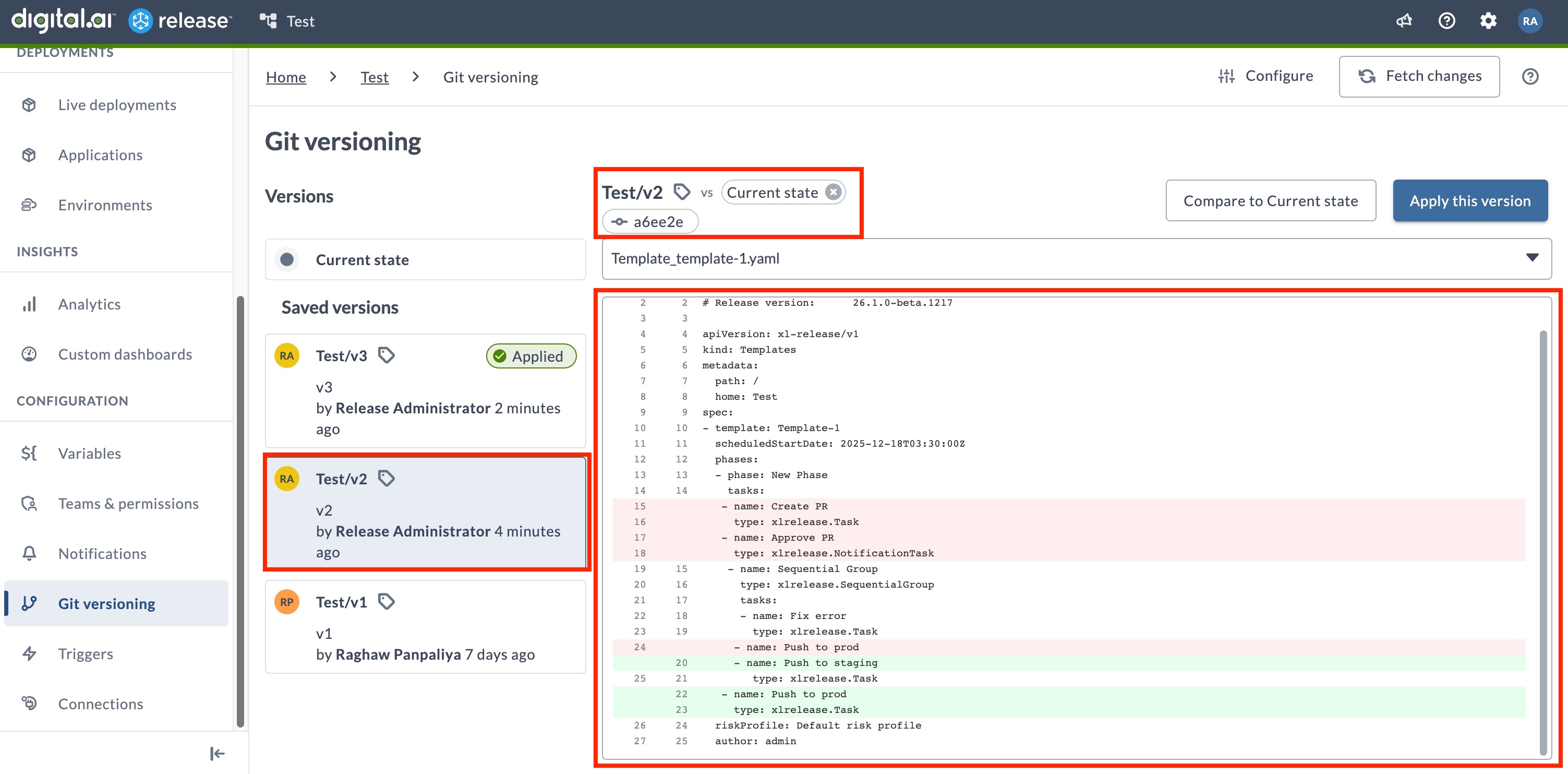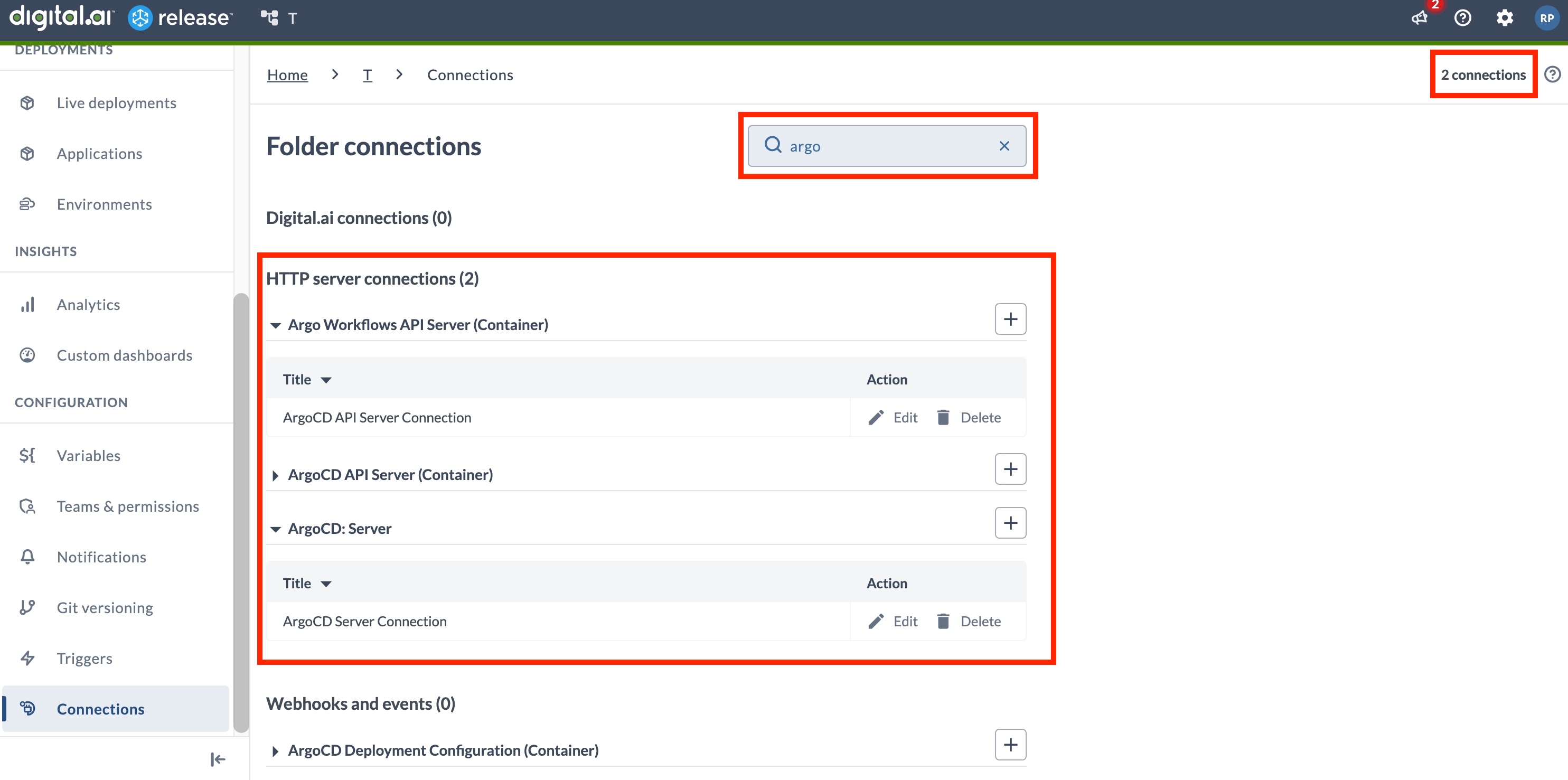Digital.ai Release 26.1.x Release Notes
Early Access (EA) Releases
- Current production: Digital.ai Release 25.3
- Upcoming: Digital.ai Release 26.1
- Monthly EA releases features and fixes listed here
- Download EA installers and plugins: Early Access Downloads
Release Operator Docker Images
Release Docker Images
Support Policy
See Digital.ai Support Policy.
Upgrade Instructions
The upgrade process depends on your current and target Digital.ai Release versions.
For upgrade instructions, see:
Breaking Changes
Please review these breaking changes in Release 26.1 before upgrading:
End-of-life Notifications
The following features are deprecated or nearing end of support.
Comparison in Git Folder Versioning
GitOps-enabled folder versioning now includes improvements that streamline configuration management and version control operations.
Compare Versions
Track and review changes between folder versions using these features:
- Compare with current state – See what's different between a saved version and your current folder configuration.
- Compare two saved versions – Compare any two saved versions to identify changes over time. Use the Compare button to select versions and filter files by change type (Added, Modified, Removed).
- View inline differences – File differences display inline with visual indicators: green highlights additions, red highlights removals, and unchanged content appears without highlighting.

Enhanced Version Actions Menu
Each saved version card now includes action options that provide quick access to:
- Compare with current state – Review differences between a saved version and current configuration
- Copy commit hash – Quickly copy the full commit hash for reference
These enhancements make it easier to manage, compare, and track folder versions across your Release environments.
For more information, see GitOps-enabled Folder Versioning.
UI and Functional Enhancements
Connection Enhancements
The Connections page, available at both the Global and Folder levels, displays the total number of available connections and the counts per connection type. A search bar lets you filter by connection type or name, and the counts update dynamically as filters are applied.

For more information, see Connections.
Passwords in Tasks Setting
A new global setting, Passwords in Tasks, has been added to configure how password variables are used in task fields. By default, password variables cannot be used in normal (non-encrypted) fields. When the setting is enabled, the Allow passwords in all fields option becomes available in Releases and Templates, which when enabled allows password variables to be used in normal fields for that particular release/template.
To configure this setting, navigate to System settings > Releases and Triggers > Passwords in tasks.
For more information, see Passwords in Tasks.
Filtering Improvements
Release 26.1 introduces a more consistent filtering experience across the Tasks, Templates, Workflow Templates, and Workflow Executions pages. Filters are now easier to review and manage, with all options available in the Filters drawer.
Tasks
The Tasks page has been reorganized to help you find what you need. Use the free-text search to filter tasks by Title, or open the Filters drawer for additional options such as ownership, status, folder, active range, and tags.
You can sort tasks by multiple fields:
- Due date – Sort by due date, with the soonest due appearing first.
- Start date – Sort by when tasks start, with earliest started or upcoming tasks first.
- Status – Sort by task status, showing Failed/Failing tasks first, followed by In Progress, then Planned.
For more information, see Filtering Tasks.
Templates and Workflow Templates
Both pages now support tag-based filtering with two modes:
- ALL – Shows templates that contain all selected tags.
- ANY – Shows templates that contain at least one selected tag.
Additionally, Workflow Templates support category filtering to filter templates based on one or more workflow categories.
For more information, see:
Workflow Executions
Filtering now aligns with the Releases page and includes:
- Search by owner – Filter by username or email.
- My workflow executions – Quick access option above the Owner dropdown.
- Tag filtering – Supports both ALL and ANY modes.
For more information, see Filtering Workflow Executions.
Account Lockout Enhancements
Enhancements to the Account Lockout feature provide administrators with more control and visibility over locked user accounts.
Manual Unlock
Administrators can now manually unlock user accounts from the Users and permissions page without waiting for the automatic lockout-duration to expire.
User List Updates
- Added Locked column to the user list for better visibility
- Sort by locked status to quickly identify locked accounts
API Updates
- User Details API - Includes lock status information
- Unlock User API - New endpoint to programmatically unlock accounts
For more information, see Configure Account Lockout.
Global Permissions Enhancements
Two new global permissions are added to enable granular control over runner management:
- View runner – Allows users to access the Runners page in Settings > Runners. Without this permission, users will not see the Runners option in the settings menu.
- Edit runner – Allows users to edit and delete runner configurations. When granted, this permission enables the Edit and Delete options for runners in the runner list.
These permissions replace the previous Runner registration permission and provide clearer separation of responsibilities.
For more information, see Configure Global Permissions.
Plugins and Integrations
The following plugins and integrations have been updated or added in this release.
ArgoCD Plugin
The following updates are introduced for the ArgoCD plugin:
- The ArgoCD: Create Application task has been renamed to ArgoCD: Create Or Update Application.
- Added support to specify Labels for the Argo CD Application when using the ArgoCD: Create Or Update Application task.
- Labels are defined as key-value pairs and applied to the Application in Argo CD.
- These labels can be used to organize, search, and filter applications in the Argo CD UI.
- Added a new Server-Side Apply option in the ArgoCD: Sync Application task.
- When enabled, Argo CD performs the sync using Kubernetes Server-Side Apply (SSA).
- Server-Side Apply allows Kubernetes to merge updates on the server, improving reliability and reducing unintended overwrites.
- For more information, see Kubernetes Docs: Server-Side Apply.
For more information, see Argo CD Plugin.
Confluence Plugin
- Added a new Is Data Center option in the Confluence: Server connection configuration. This checkbox lets Release determine which type of Confluence instance is being used.
- When enabled, Release uses Data Center–specific endpoints
- When disabled, it uses Cloud endpoints.
- Introduced a new Get HTML Page By Title task.
- Retrieving very large pages may impact release performance. If you expect the page content to be large, increase the Output variable size to avoid truncation.
For more information, see the Confluence Plugin.
Dynatrace Plugin
Added a new Allow input autocompletion option in the Dynatrace: Server connection configuration.
- When enabled, supported fields provide lookup-based autocompletion as you type.
- When disabled, the fields behave as plain text inputs without suggestions.
For more information, see Dynatrace Plugin.
Python SDK Enhancements
The Python SDK now supports explicit script location specification for improved performance and better file organization:
- Added
scriptLocationhidden property to explicitly define task implementation file paths intype-definitions.yaml. - Supports organizing Python task files in subfolders within the
srcdirectory. - By default, the SDK automatically scans all files in the
srcdirectory to find matching task classes. - Using explicit
scriptLocationreduces scanning overhead and provides better control over project structure.
For more information, see Digital.ai Release Integration Python SDK Overview.
Remote Completion Plugin
The Remote Completion plugin now supports Microsoft Graph API as an alternative email source for receiving remote completion responses, in addition to the existing IMAP support. A new Email Source configuration option has been added to support this enhancement.
Email Source – When configuring the Remote Completion: Email Server connection (previously Remote Completion: IMAP Server), you can now select between IMAP or Microsoft Graph API as the email source.
For more information, see Remote Completion Plugin.
ServiceNow Plugin
Enhanced OAuth configuration options in the ServiceNow server connection:
- Added Grant Type field (External OAuth only) to specify the OAuth grant type (e.g.,
password). - Added Scope field (External OAuth only) to define OAuth scope values.
These fields are only applicable when using external OAuth servers. ServiceNow's native OAuth does not require these configurations.
For more information, see ServiceNow Plugin.
Tekton Plugin
Added a new Wait For Pipeline Run (Container) task to wait for a Tekton PipelineRun to complete.
This task waits until the specified PipelineRun reaches a terminal state (Succeeded or Failed) and updates the Release task status accordingly. It is intended for scenarios where a pipeline run is triggered externally or by a previous step and the release must wait for completion before continuing.
For more information, see Tekton Container Plugin.